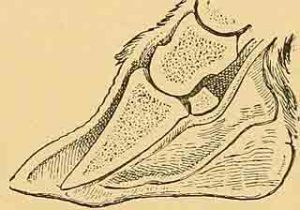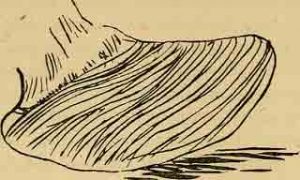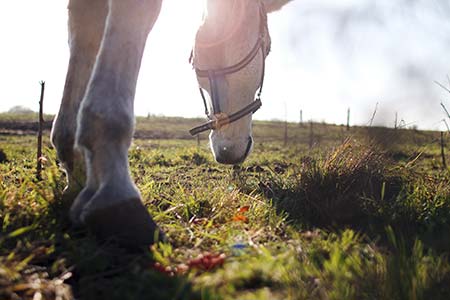Nobody wants their beloved horse to get ill or be in pain in any way, but unfortunately it isn’t something that can always be escaped. The key is to always be on the lookout and take action if your horse doesn’t appear to be in their usual state of health. What are the symptoms of equine laminitis?
What is laminitis

Equine laminitis is a severe condition that many horses, ponies and donkeys suffer with. It is extremely painful and caused by inflammation of the laminae of the foot. This is the soft tissue structures that attach the pedal bone (coffin) of the foot to the hoof wall. Once affected, a horse will usually expect repeated bouts and lasting lameness.
Acute laminitis is when the condition first sets in and although causes great discomfort, it has not yet caused lasting damage to the hoof. If diagnosed and treated in the early stages the horse’s chances of recovery are greatly improved.
Chronic laminitis causes lasting damage and is when the pedal bone sinks into the hoof or rotates downwards. In some cases, it can puncture the sole and this can lead to the heart wrenching decision of putting the horse down.
What are the symptoms

Recognising the symptoms and acting fast is key for the horse to get the treatment required and increase chances of recovery. Typical symptoms to look out for include:
- The forelimbs are usually more affected than the hind-limbs and the horse will appear to be shifting weight from limbs.
- Hooves will feel hot and soles will be sore when adding any pressure.
- The horse will become reluctant to move and adopt a ‘sawhorse’ position – rocking the weight off the affected limbs.
- The pain of laminitis will cause the horse’s pulse and respiratory rate to rise.
- Growth rings will be visible on the surface of the affected hoof wall.
- A distorted hoof shape with flared out long toes.
- Laminitic horses will often lie down to take the pressure off their hooves.
What are the causes
Some causes of equine laminitis which are known include:
-
-
- Excessive consumption of grass and grain.
- Traumatic laminitis from repeated physical trauma to the feet.
- Retained afterbirth in mares is a risk factor for systemic illness and inflammatory laminitis.
- Severe lameness in one limb will cause another limb to take the weight and may cause laminitis.
- High insulin levels as seen in EMS (Equine Metabolic Syndrome).
- Toxins released by bacteria during certain illnesses such a diarrhoea.
-
Can you prevent equine laminitis
While you can’t prevent laminitis, you can help ease the symptoms and look out for early warning signs that your horse may be affected. It still isn’t known why horses suffer with the disease but it is suspected it could be genetic. Once your horse has had laminitis they will be more prone to it. Helping ease symptoms will keep your horse healthier and happier and prevent the condition from worsening.

-
-
- Be aware – always look for symptoms and act fast. If at any point you suspect your horse is suffering with the disease then you must contact a vet.
- Keep an eye on their diet – we do know that overweight horses and ponies are more susceptible to the disease. Keeping your animal trim ensures their health is optimised and they are at less risk.
- Avoid cereal-based feeds – keep sugar and starch intake minimal.
- Avoid lush pasture – especially during the wet spring months.
- In Winter ensure that the horse is kept protected from high winds and rain, blanketed, and wear leg wraps and boots.
- Regular hoof care – ensure you consult with your vet and trim the hoof according to the degree of rotation of the pedal bone.
- Anti-inflammatory, vitamins and minerals – speak with your vet about the necessary supplements that will help support your horse.
- Hoof care – if your horse is suffering from laminitis they will need a comfortable surface to bed their hooves into a more comfortable position. The Mayo Mattress is an extremely soft and comfortable surface for the horse that will provide supreme cushioning for the hoof.
- Keep an eye on your horse’s feet – foot tenderness, a stretched white line, blood in the white line, laminitic rings and splaying of the feet.
-
Take a look at the Mayo Horse Comfort range of mattresses.
